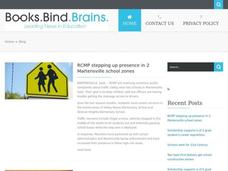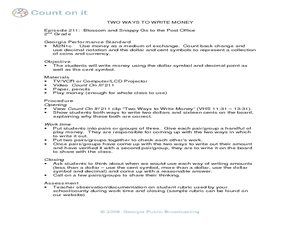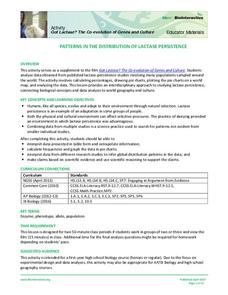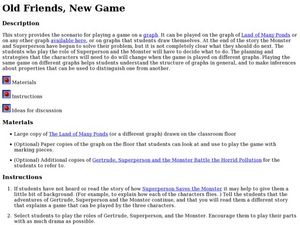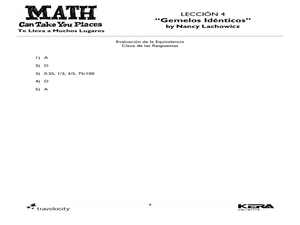Curated OER
Magnets
Students conduct an experiment. In this magnets lesson, students review what they know about magnetism, work in groups to determine the magnetism of various objects and discuss their results.
Curated OER
What did I find?
Students excavate an artifact. In this archaeology lesson plan, students get a bucket filled with dirt and a broken up artifact. They work in groups to take it out and to find what its purpose was.
Curated OER
Quilting
Second graders make a quilt. In this cultural diversity lesson, 2nd graders review their knowledge of the Metis people. Students work in groups to create a class quilt that illustrates the lives of these people. Quilt themes include...
Curated OER
Two Ways to Write Money
Second graders complete activities to learn about money and how to write money. In this money instructional activity, 2nd graders watch a video about ways to write money. Students work in groups with play money and come up with two ways...
Howard Hughes Medical Institute
Patterns in the Distribution of Lactase Persistence
We all drink milk as babies, so why can't we all drink it as adults? Examine the trend in lactase production on the world-wide scale as science scholars analyze and interpret data. Groups create pie charts from the data, place them on a...
Teach Engineering
Magical Motion
Make solutions to projectile motion problems magically appear using equations. Pupils watch a clip from a Harry Potter movie and find the length of time it takes for a remembrall to fall into Harry's hands. They use a projectile motion...
Curated OER
Curiosity Does Not Kill The Cat
Students list the different ways they could test a guinea pig, a dandelion, and their brother (or sister)? They create a data chart in their group that lists the organism, what they could measure, and how they could change that measurement.
Curated OER
Constructing a Perpendicular Bisector
Students practice constructing a perpendicular bisector. During a demonstration, they discover the meaning of bisector and perpendicular and answer questions why these steps shown are going to work. They use a compass and a...
Curated OER
Pedal Triangles
Students identify the properties and theorems of triangles. In this geometry lesson, students construct angle bisectors using a compass and straight edge. They identify triangular similarity and congruency.
Curated OER
Menelaus' Theorem
Students investigate Menelaus Theorem. In this geometry lesson, students calculate the area of polygons. They differentiate between boundaries point, interior points and area of lattice points.
Curated OER
Ceva’s Theorem
Students prove and use Ceva's Theorem to solve problems. In this geometry lesson, students analyze polygons for patterns and calculate the area of each shape. They relate polygons to the real world.
Curated OER
Conditional Statements
Learners are introduced to the topic of proofs in Geometry. During a PowerPoint presentation, they take notes on indirect proofs and have groups of students write a true statement. They are assessed on the statement and how well they...
Curated OER
Can You Canula?
Students calculate the circumference of a circle. In this geometry lesson, students measure the diameter of a circle using micrometers or calipers. They investigate the relationship of the diameter to that of the value of Pi.
Curated OER
Putting It Together
Students create number combinations. In this problem solving lesson, students participate in a classroom activity that requires them to create as many object combinations as possible and multiplication sentences that compliment the...
Curated OER
Old friends, New game
Students create characters from a book. In this Language arts instructional activity, the students act out the story by role playing. The students learn how to articulate correctly, by working together to arrive at the same destination.
Curated OER
Amazing Fibonacci
Students integrate the patterns of Fibonacci into music. In this geometry lesson plan, students apply the concepts of recursion, pattern and Phi or Golden Ratio to composing and playing music on various instruments. They lesson plan is...
Alabama Learning Exchange
The Five Senses: How They Relate to our World
Students explore the five senses and the significance of each sense. In this five senses and diversity lesson plan, students listen to You Can't Smell a Flower With Your Ear by Joanna Cole and take a walk observing opportunities to use...
Curated OER
Catholic Schools in the Community
Students are provided with a multimedia Power Point presentation that explains the educational opportunities that are available at the St. Mary Catholic School. They are presented with all facts along with the community as a whole and...
Curated OER
Understanding Presidential History
Students research to find the qualifications necessary to be President of the U.S. In this presidential qualification lesson, students research their family roots to see if they could qualify to be President. Students create a graph to...
Curated OER
When Are We Ever Going To Use This?
Learners explore the relationships between fractions, decimals, and percents in a real-world context. They examine examples of percents from magazines and newspapers, and create posters that depict the use of percents in articles and...
Curated OER
Geometry Poetry
Students write an original diamante poem about a shape of their choice. They examine how to write a diamante poem, and select a shape and write a poem using Microsoft Word software.
Curated OER
Identical Twins
Sixth graders work with equivalent fractions, decimals, and percents. In this equivalency lesson, 6th graders participate in a number of activities aimed at increasing their understanding of equivalent expressions. They form a human...
Curated OER
The "Art" of Baseball
Students investigate the art of baseball. In this sports lesson plan, students discuss their thoughts about the sport of baseball and create a baseball word list. Students use pattern blocks and drawing paper to create a simulated...
Curated OER
What Color Are Your Skittles?
Students create spreadsheets and manipulate data. They collect data, create appropriate graphs and use percentages to describe quantities. Students compare and contrast data. They use spreadsheets to generate a pie chart.




